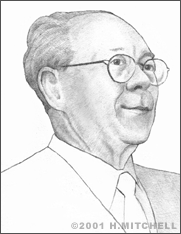Newman Darby
In the summer of 1964, a new sport was born out of an idea conceived by Newman Darby while vacationing on Wyoming Mountain in Pennsylvania. That sport was windsurfing, and it quickly became a multi-million dollar industry.
Darby had been an avid boater as a child and even attempted to build one when he was just 12 years old. His first try was a failure; it sank. His second attempt at age 14 was more successful. At 20 years of age, he came up with the idea of using a handheld sail system mounted on a universal joint for a small catamaran. He also designed experimental trimarans, or three-hulled boats, catamarans, and kayaks.
Darby invented the first windsurfer, which he called a “sailboard,” after watching his girlfriend, Naomi, sail on a boat that he had built from ashore. She sailed while standing up, controlling the boat without the use of a rudder. Rather, she tilted the sail to change directions. This was something that had never been done before. Earlier, he had planned to test steering with his handheld sail system on a larger catamaran that he invented, but after his experience with Naomi on Wyoming Mountain, the pair decided to install the handheld sail system on a surfboard instead. Newman then built an extra wide stable test hull, and Naomi sewed the sail. This became the prototype of the first Darby sailboard.
In 1964, Darby and his girlfriend married, and they quickly began talking with relatives about their idea to manufacture sailboards. That year, Darby’s brother Ken quit his job to help begin forming the world’s first sailboard business. They called it Darby Industries, Inc. Ken Darby became the president, Newman Darby was the designer, and Naomi Darby worked on promotions.
A series of improvements to Darby Industries’ sailboards quickly followed. In January 1965, the company made their first metal universal joint for the mast foot. Later that year, a sailboarder named Diane Albrecht impressed a photographer by outrunning the motorboat from which he was shooting pictures. Also in that year, Darby met with his other brother Ronald, who helped him to study the use of other sail rig designs that may be used. Soon after, the pair designed a sloop rig for sailboards. The main sail on this sloop rig became the popular three-sided shape.
Later that year, Charles Hawk, a Darby Industries stockholder and sailboard rep from Virginia, wrote up the first patent application papers for Darby Industries. Popular Science published a four page article on sailboarding, which helped ignite a fire that spread the sport’s popularity overseas. Hundreds of letters arrived at Darby Industries inquiring about the sailboards, from as far away as India.
Nevertheless, the Darbys phased out their production of sailboards by the late 1960s as sales were not going very well. It wasn't until Jim Drake and Hoyle Schweitzer created what they called a Windsurfer in the 1970s that the boards began being mass-produced. The duo based the Windsurfer on Darby’s original ideas and fully credit him with its invention.
Finally, the fledging sport of windsurfing really took off, especially in Europe. Europeans took up windsurfing in masses, and at one point, one in every three households owned a board. Dozens of European manufacturers produced their own versions of the Windsurfer. Eventually, the sport was even included in the Olympics.
Meanwhile in the United States, Darby industries lived on, and the company began producing boats, bathtubs, and sinks. Newman Darby himself continued to invent watercrafts. In the 1980s, for example, Darby received a design patent for a one-person sailboat called the Darby 8 SS sidestep hull.


